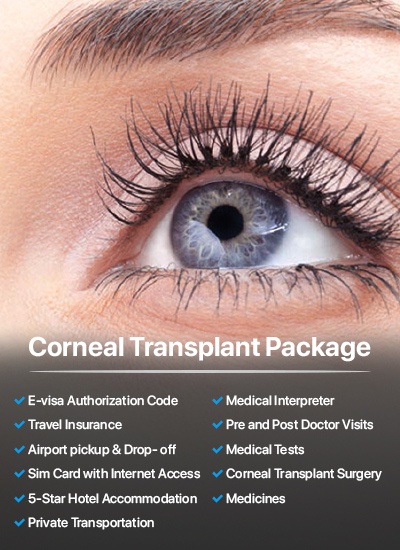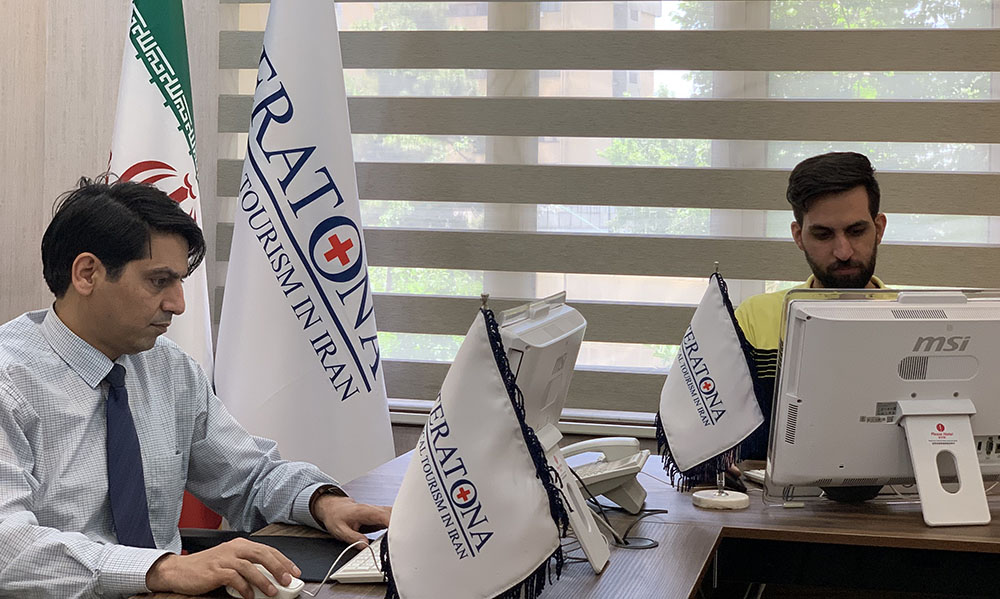What is cornea?
The cornea is a transparent layer in front of the eye, like a completely transparent window, that allows light to enter the eye. Color of the eye has nothing to do with cornea. Due to its special refractive trait and curvature, cornea is able to change the direction of light, which focuses the images of distant and near objects on the retina with the help of the eye lens, enabling a person to see objects.
What is corneal transplant?
Corneal transplant is a surgery in which all or part of a diseased cornea is replaced by healthy cornea donated from a deceased person. Before the transplant surgery, donated cornea is fully examined and its health is fully tested by the eye bank. Corneal transplantation is usually performed under general anesthesia.
Common Methods of Corneal Transplantation
1- Full-thickness corneal transplant: In this case, the full thickness of the cornea in affected area is removed and replaced with a healthy cornea.
2- Layered corneal transplant: In this method, only damaged layer of the cornea is removed and the healthy layer is transplanted instead.
Types of layered Corneal Transplant
1- Anterior layer graft (ALTK): Only the surface layer of the damaged cornea is removed and replaced with a similar part of the graft cornea.
2- Anterior and middle layers transplantation (DALK): It is used in cases where the patient has a widespread disorder in upper layers of cornea.
3- Posterior layer transplantation (DSAEK): It is used in cases where the patient has a disorder (diseased cornea) in the deep layer (endothelium) but surface and middle layers remain healthy. The thickness of this bonding layer is about 90 to 180 microns.
4- Posterior layer transplantation (DMEK): Another method is endothelial transplantation in which a very thin membrane 5 to 10 microns thick is transplanted.
Causes of Corneal Transplantation
1- In patients with keratoconus to increase visual acuity, not doing transplant surgery may lead to progressive reduction of vision, thinning cornea and even cornea rupture.
2- Improving blurred vision in patients with corneal opacity issue
3- Maintaining the integrity of the eye in severe corneal rupture due to an accident
4- In cases of severe infections
5 – To improve unpleasant appearance of stained cornea, which use of cosmetic lenses due to the patient’s intolerance or lack of stabilization of colored lenses, corneal transplantation remains the only solution.
Suitable candidates for Corneal Transplant Surgery
1- Keratoconus (conical cornea) is a condition when the normally round cornea becomes thin and develops a cone-like bulge.
2- Having corneal inflammation after cataract surgery or other intraocular operations
3- Inherited diseases that cause turbidity or inflammation of the cornea.
4- Existence of turbidity or stain in cornea, which is usually caused by recurrent herpes infection or microbial infections.
5- Chemical corneal burns
How is donated cornea supplied?
Cornea donation is provided by deceased people who wanted to donate their cornea to help others, and without the benevolent action and consent of these people, corneal transplant surgery is not possible.
All donated corneas in the eye bank are thoroughly examined to make sure they are healthy. Also all donated corneas are tested for diseases such as AIDS and hepatitis and… so that these diseases do not spread to recipient.
Note: The fee paid to the eye bank is only for examinations, tests and corneal preservatives.
Corneal Transplantation Process
Corneal transplant surgery usually requires the patient to undergo the necessary tests and examinations. For donated cornea is usually coordinated with the eye bank before the patient is admitted to the hospital, but in some cases, the cornea may not be available at the eye bank on the day of surgery and the surgery may be postponed to another day.
During the operation, the surgeon uses a microscopic instrument to remove a circular piece from the center of the patient’s cornea and instead inserts a similar round piece of healthy donor cornea and sutures it to the patient’s eye with very fine sutures. It should be noted that surgery takes between one and two hours. Depending on the condition, cataract or glaucoma is sometimes performed in addition to corneal transplants. After the operation, the eye is bandaged.
Note: The patient’s cornea and the donated cornea can also be prepared by femtosecond laser, in which case the cost of the operation increases due to the use of this device.
Essential Postoperative Care
Immediately after a corneal transplant surgery, the eye is very sensitive to trauma and may suffer serious damage, even with minor trauma. Therefore, it is necessary to use a plastic protector for one month after the transplant surgery so that nothing does not hit the eye. You should also avoid bending, forcing, or lifting heavy objects during these times. You should not bend your head forward. If you have to lift something off the ground, do not bend at the waist, but bend your knees and keep your head straight. When washing your head, make sure that water and shampoo do not get into your eyes. The only sport activity allowed in this course is light walking. Rubbing and scratching the eyes should be avoided during this period.
Note: If your job is an office job, you can return to work after two weeks, but if your job requires physical activity, you must rest for at least 6 weeks to return to work.
Important Postoperative Recommendations
Since the tissue heals very slowly in corneal transplantation and never has normal corneal strength after welding/healing, the following points should be observed:
1- Always wear large sunglasses or prescription glasses to prevent accidental shocks.
2- Avoid sports such as judo, wrestling and football where there is a risk of injury.
3.Avoid activities in which there is a possibility of injury and do not engage with anyone.
4- Be sure to wear goggles when swimming or regular sports.
Note: Failure to follow these tips can come at the cost of vision loss.
Clinical and Pharmaceutical Care
For corneal transplant patients arranged by Teratona after their transplant surgery, they will have another doctor visit day before he or she will be flying back home and departs Iran. Back in home, the patient must visit regularly local doctor as instructed for postoperative examination.
Corneal Transplant Result
The outcome of corneal transplantation largely depends on the primary disease for which the corneal transplant was performed.
In people who have undergone surgery for keratoconus, non-infectious corneal spots, or mild corneal inflammation, the success rate is very good at about 90%. In cases where corneal transplant has been performed due to spots caused by herpes or severe corneal inflammation, the success rate of the operation is over 80%. In emergencies where a corneal transplant is performed to control an infection or repair a corneal perforation, the transplanted cornea is less likely to remain transparent, but corneal transplantation is done to preserve the structure of the eye.
Problems and Complications
The most common complication of corneal transplantation is astigmatism, which usually improves somewhat with the adjustment and removal of sutures and the use of glasses or contact lenses.
Another important complication is graft rejection, which if not treated in time, can cause the graft cornea to become cloudy. Transplant rejection occurs when a patient’s immune system recognizes a transplanted cornea as foreign tissue and tries to destroy it. This condition can start as early as two weeks after transplantation but usually occurs a few months later. If the rejection is detected early, it can be controlled by repeated use of steroid drops and sometimes oral pills or injections around the eye, but in advanced stages, rejection may not be controlled by the drug and re-transplantation may be needed. Its success rate is less than the initial transplant. Therefore, it is recommended that you see an ophthalmologist within 24 hours if you experience any of the following symptoms in an eye with a transplanted cornea:
1- Pain
2- Severe redness of the eyes or around the cornea
3- Sensitivity to light
4- Abnormal tearing
5- Blurred vision
6- The feeling of a foreign body that can be caused by loosen or torn stitches.
Other major complications of corneal transplantation are less common, but there is a possibility of complications such as intraocular bleeding, infection, cataracts, glaucoma, and recurrence of a previous disease in the transplanted cornea, and rupture of the retina.







